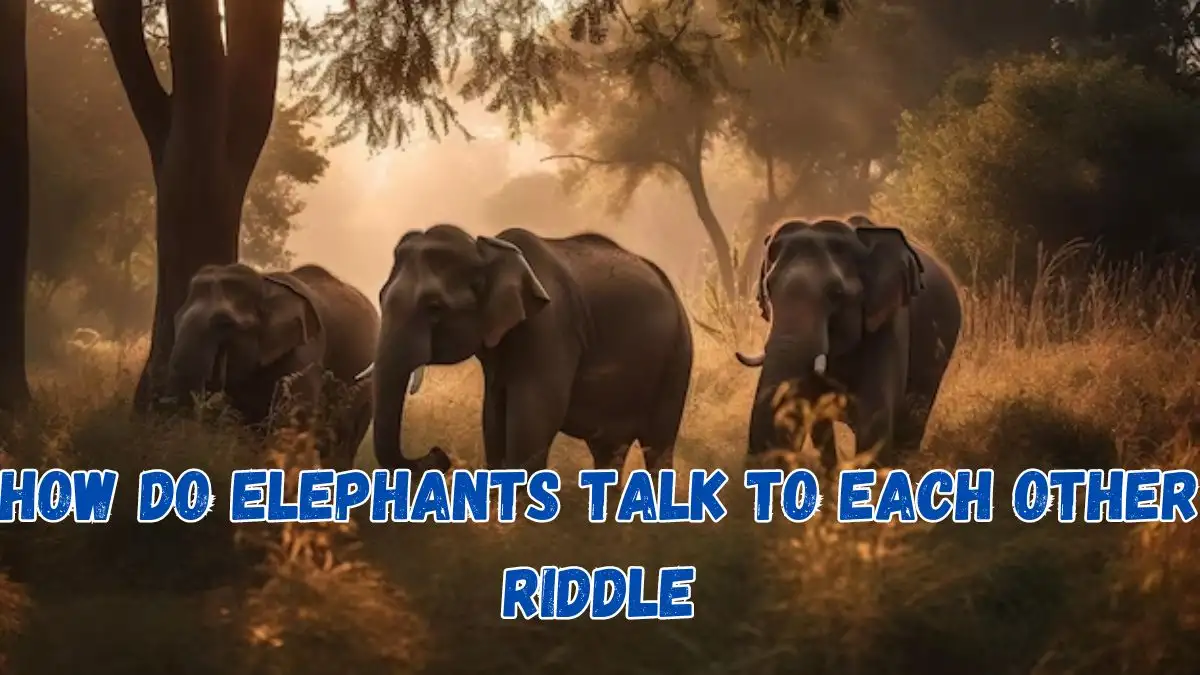How Do Elephants Talk to Each Other Riddle Answer Solved and Explained
by Priyanka P
Updated Nov 30, 2023

How Do Elephants Talk to Each Other Riddle
Elephants communicate in fascinating ways, relying on a variety of methods to convey information within their herds. One essential form of communication is vocalization, where they produce trumpets, rumbles, and other distinct sounds. These vocalizations serve different purposes, from expressing excitement to warning others about potential dangers.
Elephants also utilize body language, using their trunks, ears, and tails to express emotions and intentions. They may flap their ears when agitated or trumpet loudly to alert the herd. Additionally, elephants leave scent markings to convey information about their age, gender, and reproductive status.
Through a combination of vocal signals, body movements, and scent cues, these intelligent creatures maintain a complex social structure, ensuring effective communication within their tight-knit communities.
Dive into the enigmatic world of riddles where we unravel the mysteries behind these captivating puzzles and provide solutions that enlighten and entertain. Follow Fresherslive to get all the latest riddle answers.
How Do Elephants Talk to Each Other Riddle Explained
Elephants talk to each other through a playful play on words: "On the elephone." This is a clever pun, combining "elephant" and "phone." The humor lies in the substitution of "ele" in "elephant" for "tele" in "telephone." So, the answer to the riddle is a playful way of saying that elephants talk on the "elephone."
While real elephants communicate using trumpets, rumbles, body language, and scent markings in their natural habitats, the riddle takes a lighthearted and imaginative approach by suggesting a fictional communication device, the "elephone." The riddle highlights the creative and amusing side of language, making it a fun and enjoyable wordplay for those who appreciate clever linguistic twists.
What is Riddle?
A riddle is a type of puzzle or word game that presents a mystery or question in a clever and often cryptic way. It typically involves a statement, question, or phrase with a hidden or double meaning, challenging the person to figure it out. Riddles come in various forms, such as enigmas, which require creative thinking and metaphorical interpretation, and conundra, which rely on wordplay or puns in the question or answer.
Riddles have been part of human culture for centuries and can be found in many different cultures worldwide. They are like brain teasers, designed to engage the mind and encourage problem-solving. People enjoy riddles for the mental challenge and the satisfaction of unraveling the hidden meaning. Riddles often serve as a form of entertainment and intellectual exercise, and they can be a fun way to test and expand one's thinking abilities.
Advantages of Solving Riddle
Solving riddles offers several advantages, making it an enjoyable and beneficial activity:
Mental Stimulation:
Riddles require critical thinking, creativity, and problem-solving skills. When you solve a riddle, you exercise your brain, keeping it active and sharp.
Enhanced Problem-Solving Skills:
Riddles often present complex challenges in a concise format. Solving them hones your ability to analyze information, think logically, and find innovative solutions.
Improved Language Skills:
Riddles play with words, encouraging better vocabulary, wordplay, and linguistic comprehension. They can be an enjoyable way to learn new words and phrases.
Boosted Confidence:
Successfully solving a challenging riddle can be incredibly satisfying, leading to increased self-confidence and a sense of accomplishment.
Entertainment:
Riddles are a source of entertainment and amusement, whether solved individually or as part of a group. They can be a fun way to pass the time.
Social Interaction:
Riddles often prompt discussions and interactions among people trying to solve them together, fostering teamwork and communication.
Cultural Understanding:
Riddles are found in many cultures, and solving riddles from different parts of the world can offer insights into diverse perspectives and traditions.
Creativity:
Riddles encourage thinking "outside the box" and inspire creative solutions to problems.
How Do Elephants Talk to Each Other Riddle - FAQs
It's a playful wordplay joke, humorously suggesting how elephants might communicate using a fictional "elephone."
The riddle playfully suggests elephants talk on an imaginary "elephone," showcasing a clever wordplay with humor.
The pun adds humor by blending "elephant" with "telephone," creating a whimsical scenario about how elephants might talk to each other.
It cleverly substitutes "ele" from "elephant" for "tele" in "telephone," creating a witty and imaginative play on words.
A good riddle often involves clever wordplay, ambiguity, or a hidden meaning that challenges the solver's intellect, encouraging them to think creatively and solve the puzzle.







